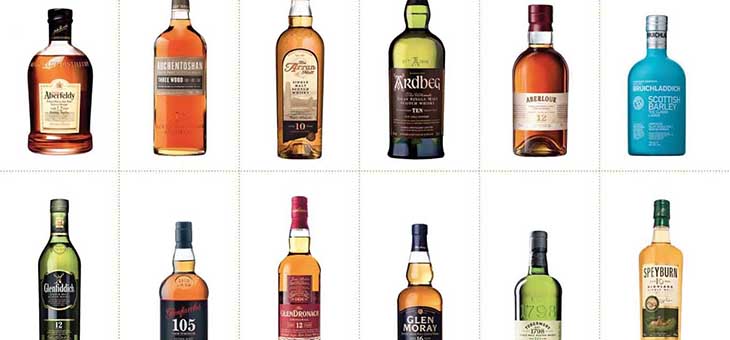Australia is largely unknown as a whisky producing nation, but it is home to more than 50 whisky distilleries. Most are small and their wares are consumed domestically. Starward, in Melbourne, is believed to be the only one to regularly export in significant volume to the United States.
According to Hamish Fyfe, business manager of glass spirits at Dan Murphy’s, there is such a thing as the ‘Mad Men’ effect and it’s taking place in Australia right now.
“A lot of it is driven by the number of whisky bars popping up, and the fact general consumer consumption is moving away from volume to premium beverages,” says Mr Fyfe.
“It’s what we call the ‘Mad Men’ effect. We’re seeing cocktail culture and club culture creep back into society a little bit, and the proliferation of whisky bars and cocktail bars end up driving retail trends over time.”
If you’re ready to hop on the whisky train, there are a few things to know. It’s important to get to grips with the basics so you can truly appreciate the style and flavours.
Made from three simple ingredients – grain, water and yeast – Scotch can veer from fragrant to fruity, from rich to smoky, and can be enjoyed neat or with ice and a splash.
1. What are the different types of Scotch whisky?

Single malt whisky
Made from malted barley and distilled in batches in copper pot stills. It’s produced by one single distillery. The well-known brands include Glenfiddich, The Glenlivet, The Macallan, Lagavulin, Laphroaig and Oban.
Single grain whisky
Made from a different type of grain, usually corn or wheat, in 30ft-high column stills using a process of continuous distillation. Usually, a small percentage of malted barley is added as a catalyst. Well-known brands include North British, Black Barrel and Cameron Brig.
Blended malt whisky
A mixture of single malts only, from various distilleries. There is no grain whisky in a blended malt. This type of whisky is sometimes called a vatted malt or a pure malt. John Walker & Sons Odyssey, Monkey Shoulder and Johnnie Walker Green Label are the brands to look out for.
Blended grain whisky
A mixture of various grain whiskies. This is a rather rare type, not often seen on store shelves. Snow Grouse, the brother of The Famous Grouse, serves as a good example.
Almost 90 per cent of Scotch is blended whisky.
Blended whisky
A mixture of mature malt whiskies from various distilleries, blended with a certain amount of mature grain whisky. The percentages of the two types vary by brand.
The well-known brands include The Famous Grouse, Johnnie Walker, Ballantine’s, Chivas Regal, Black Bottle and Dewar’s.
2. Is older whisky better than younger whisky?

Older whiskies aren’t necessarily better than younger ones per se. Age is a number; maturation is character.
Some whiskies want to stay in the cask for a long time; others should be released into the world sooner. Producers also play around with different ages to increase the variety of their assortment, while maintaining the quality of their products.
3. Is whisky always matured in wooden casks?

Whisky has to mature in wooden casks, otherwise the bottled spirit isn’t whisky. Most countries specify oak as the only permitted wood for casks. The character of the wood has a huge influence on the eventual taste of the whisky.
By law in Scotland, all Scotch whisky has to mature in oak casks for a minimum of three years.
4. What is the angels’ share?
Oak casks and barrels breathe, which is why some of their content evaporates during maturation. The percentage of liquid that evaporates annually from a cask is called the angels’ share.
5. How many single malts come from Scotland?

There are about 120 working distilleries in Scotland. However, every distillery makes various versions of their single malt and may give them different names.
The Macallan, for example, produces a special series of single malts called Gold, Amber, Sienna, and Ruby.
6. What is the effect of adding water to whisky

Adding water ‘opens’ the whisky and reveals more aromas. But beware – too much of it can drown the flavour, and old whiskies may completely collapse.
A plastic pipette is a handy tool for adding water by the drop.
There’s no golden rule; in the end, how much water to add is a matter of trial and error, and personal preference.
7. What type of glass should I use to drink whisky?
Nosing and tasting start with the choice of the perfect drinking vessel. The well-known broad tumbler glass makes drinking easy and is suitable for whisky on the rocks.
If you like mixing whisky with ginger ale, cola or soda water, you may prefer a tall glass.
But if you’re looking for the finer nuances in flavour and aroma, you may want to try a special tasting glass: tapered on the top, rounded at the bottom.
In this type of glass, sometimes referred to as tulip or copita, whisky can be well swirled, and the narrow opening prevents aromas from escaping too quickly. Pour about an ounce into the glass, swirl the whisky slowly, and take the time to enjoy its colour.
What’s your alcoholic drink of choice? Do you drink whisky? Have you noticed an increase in whisky options in the past few years?
– With PA
If you enjoy our content, don’t keep it to yourself. Share our free eNews with your friends and encourage them to sign up.
Related articles:
https://www.yourlifechoices.com.au/lifestyle/leisure/how-to-host-a-wine-tasting
https://www.yourlifechoices.com.au/fun/entertainment/cocktail-culture-through-the-years
https://www.yourlifechoices.com.au/health/your-health/what-alcohol-does-to-brain-and-body

